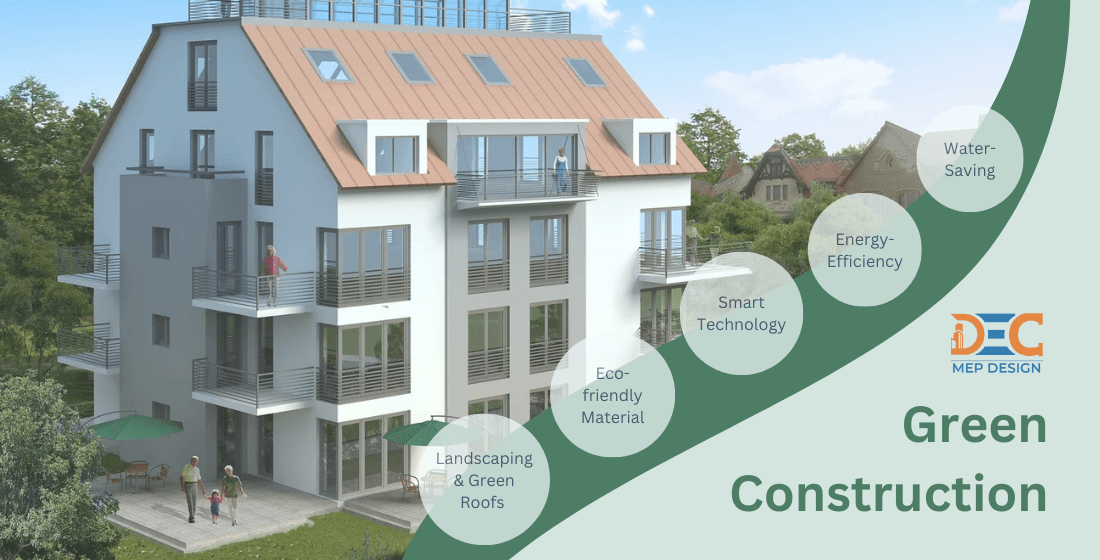Green construction is now a key trend in the building industry, mainly due to climate change and increasing environmental awareness. By utilizing sustainable materials and environmentally friendly practices, builders can produce durable, efficient buildings with less negative environmental impact. Implementing green construction concepts in your residential, commercial, or industrial building project is an intelligent financial and social decision.
Here’s how to make your next building project more environmentally friendly.
1. Energy Efficiency Designing
The design is the basis of any green building. Energy consumption through artificial heating, cooling, and lighting can be minimized by using energy-efficient design components like appropriate insulation, passive solar heating, and natural ventilation. Energy use can also be reduced greatly through energy-efficient windows and doors and natural lighting.
2. Environment-Friendly Materials
A key component of green construction is using environmentally friendly building materials. Choose sustainable materials such as engineered stone, bamboo, or repurposed wood. Recycled concrete and steel can reduce waste without sacrificing structural integrity. Low-VOC paints and finishes improve interior air quality and protect inhabitants’ health.
3. Integration of Renewable Energy
For example, solar panels and wind turbines are renewable energy sources that can offset electricity use and lower utility expenses. Over time, even modest renewable energy installations can make a significant reduction in the carbon footprint of a building.
4. Water-Saving Features
Water usage can be reduced through the use of water-saving technologies such as rainwater harvesting systems, dual-flush toilets, and low-flow faucets. To further enhance sustainability, greywater recycling systems can recycle wastewater for non-potable applications such as irrigation.
5. Smart Technology
Smart building technologies rely on data-driven insights and automation to maximize energy use. Motion-sensor lights, energy monitoring systems, and smart thermostats can all significantly enhance energy efficiency and reduce waste.
6. Landscaping and Green Roofs
Living walls and green roofs improve biodiversity, reduce the impact of urban heat islands, and provide better insulation. In landscaping, native and drought-tolerant plants reduce the amount of water and maintenance required.
Conclusion
Green construction is a new way to build that benefits society, the environment, and your wallet. It is not just a craze. Your next building project can be a shining example of environmentally aware innovation, incorporating the most advanced technologies, sustainable materials, and energy-efficient designs. Taking sustainability as your priority today will ensure a healthy planet for the generations that follow and will add more usefulness and value to your property. Let your next building project set the standard for environmentally responsible construction.
DEC experts are here to help you implement sustainable MEP solutions for a greener future. With our expertise, make your next project eco-friendly and energy-efficient.
How to Get Started with Green Construction for Your Project
- Set Your Sustainability Goals:
Define what aspects of green construction are most important for your project, such as energy efficiency, water conservation, or renewable energy integration.
- Consult with Green Building Experts:
Partner with MEP engineers, architects, and contractors who specialize in sustainable design to create an eco-friendly blueprint.
- Select Certified Green Materials:
Choose materials with certifications like LEED, Energy Star, or FSC to ensure they meet environmental standards.
- Plan for Renewable Energy Integration:
Identify opportunities to install solar panels, wind turbines, or geothermal systems to reduce long-term energy consumption.
- Incorporate Smart Technology:
Install smart thermostats, motion-sensor lighting, and energy monitoring systems to optimize energy usage.
- Design Water-Efficient Systems:
Add water-saving fixtures and rainwater harvesting systems to minimize water waste.
- Regularly Monitor and Maintain Systems:
Schedule routine maintenance and energy audits to keep your building operating at peak efficiency.
Frequently Asked Questions:
Green construction refers to the practice of designing, building, and operating structures using sustainable materials, energy-efficient systems, and environmentally friendly methods. It helps reduce carbon footprints, lower energy costs, and improve overall building efficiency while preserving natural resources.
Popular sustainable materials include bamboo, engineered stone, recycled concrete, reclaimed wood, and low-VOC paints. These materials reduce environmental impact without compromising quality and durability.
Renewable energy sources such as solar panels and wind turbines reduce reliance on fossil fuels, lower energy bills, and minimize the carbon footprint of buildings.
Water-saving technologies include rainwater harvesting systems, dual-flush toilets, low-flow faucets, and greywater recycling systems, all of which help conserve water and reduce utility expenses.
Smart technologies like motion-sensor lighting, energy monitoring systems, and smart thermostats help automate and optimize energy usage, reducing waste and lowering overall energy consumption.
While the initial cost of green construction may be higher due to sustainable materials and advanced technologies, long-term savings on energy, water, and maintenance typically outweigh the upfront investment.
Green roofs and native landscaping improve insulation, enhance biodiversity, reduce heat island effects, and lower water consumption, contributing to a healthier environment.





No comment